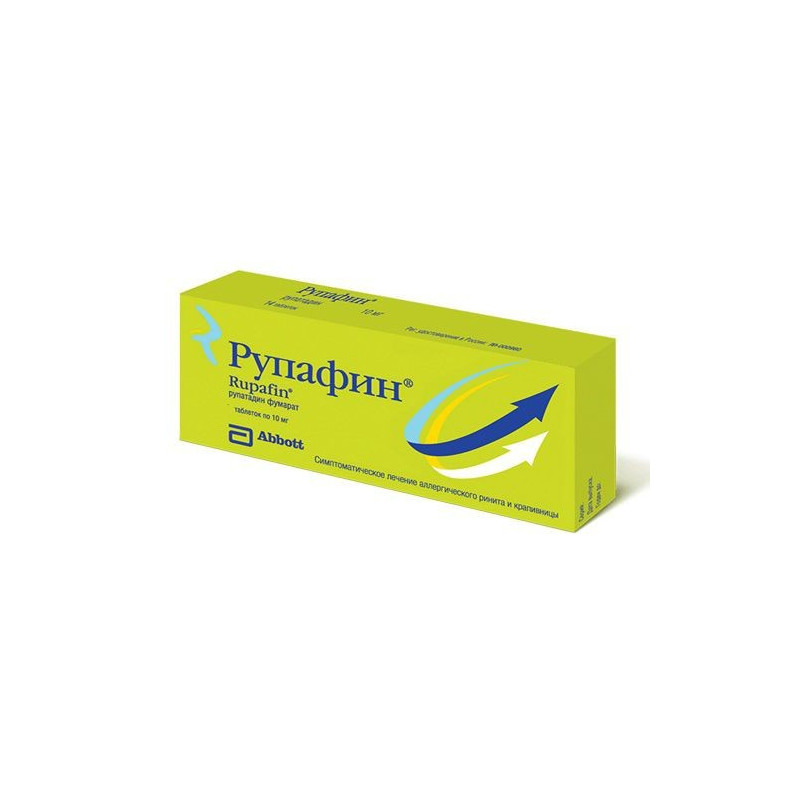



 All payments are encrypted via SSL
All payments are encrypted via SSL
 Full Refund if you haven't received your order
Full Refund if you haven't received your order
Release form
Pills
Composition
1 tab. contains rupatadina 10 mg
Packaging
7 pieces
Pharmachologic effect:
Rupatadin belongs to the second generation of antihistamine drugs and is a long-term and selectively acting peripheral H1-histamine receptor blocker. Some of its metabolites (desloratadine and 3-hydroxydiseloratadine) retain antihistamine activity and may contribute to the overall effectiveness of the drug Rupafin.
Rupatadin shows a high affinity for the H1-histamine receptors. In vitro studies of rupatadine in high concentration showed suppression of mast cell degranulation caused by immunological and non-immunological stimuli, suppression of chemotaxis of eosinophils and neutrophils, as well as release of cytokines (interleukin (IL) -5, IL-6, IL-8, GM-CSF ( granulocyte-macrophage colony-stimulating factor)), in particular TNF-α (tumor necrosis factor alpha) from human mast cells and monocytes. In addition, rupatadine caused a dose-dependent suppression of the expression of neutrophil adhesion molecules.
Due to the selectivity of rupatadine in relation to peripheral H1-histamine receptors, it does not significantly affect the activity of the central nervous system in doses of 10 or 20 mg / day.
Indications:
Symptomatic treatment in adults and adolescents over 12 years old:
allergic rhinitis;
chronic idiopathic urticaria.
renal failure;
liver failure;
pregnancy;
lactation period;
children's age up to 12 years (efficiency and safety are not established);
rare hereditary intolerance to galactose, lactase deficiency or glucose-galactose absorption insufficiency syndrome;
hypersensitivity to the components of the drug Rupafin.
Caution should be given to patients with a prolonged QT interval, uncorrected hypokalemia, persistent proarrhythmic conditions, such as clinically significant bradycardia, acute myocardial ischemia; elderly patients (65 years and older); simultaneously with the statins, simultaneously with grapefruit juice.
Dosage and administration:
Rupafin is taken orally, regardless of the meal. In adults and children over 12 years old, the recommended dose is 10 mg (1 tablet) 1 time / day.
Side effects:
Most often, patients receiving rupatadine reported adverse reactions to the drug, such as drowsiness, headache, and fatigue, occurring in 9.5%, 6.9%, and 3.2% of patients, respectively. In most cases, drug withdrawal was not required.
Classification of adverse reactions according to the frequency of development (number of registered cases / number of patients): very often - more than 1/10 cases, often - from 1/10 to 1/100 cases, infrequently - from 1/100 to 1/1000 cases.
From the nervous system: often - drowsiness, headache, dizziness, fatigue, asthenia; infrequently - decreased concentration, irritability.
On the part of the respiratory system: infrequently - nosebleeds, dry nasal mucosa, pharyngitis, cough, dry throat, pain in the throat and larynx, rhinitis.
On the part of the digestive system: often - dry mouth; infrequently - nausea, diarrhea, dyspepsia, vomiting, abdominal pain, constipation.
Metabolism and nutrition: infrequently - increased appetite.
On the part of the skin and subcutaneous tissues: infrequently - a rash.
From the musculoskeletal system: infrequently - back pain, arthralgia, myalgia.
On the part of the organism as a whole: infrequently - thirst, indisposition, fever, weight gain.
Changes in laboratory parameters: infrequently - increased CPK, ALT, AST, changes in functional liver function tests.
Drug Interactions:
Interaction with Ketoconazole and Erythromycin :
The combined use of rupatadine in a dose of 20 mg and ketoconazole or erythromycin enhances the systemic effects of rupatadine 10 times and the latter - by 2-3 times. These combinations are not accompanied by changes in the QT interval or an increase in the frequency of adverse reactions compared with the separate use of these drugs.
However, rupatadine should be used with caution in conjunction with these drugs and with other inhibitors of the CYP3A4 isoenzyme.
Interaction with grapefruit juice:
The simultaneous intake of rupatadine and grapefruit juice 3.5 times enhances the overall effect of rupatadine. Do not eat grapefruit juice while taking the drug.
Interaction with ethanol:
With simultaneous use with ethanol, rupatadine in a dose of 10 mg does not cause a more pronounced change in cognitive, psychomotor activity compared with ethanol alone. Rupatadin, taken in a dose of 20 mg, enhances the changes caused by the intake of ethanol.
Interaction with drugs that inhibit the central nervous system
We can not exclude the possibility of the interaction of rupatadine with other antihistamines and drugs that depress the central nervous system.
Interactions with statins:
Due to the fact that some of the statins, as well as rupatadin, are metabolized by the cytochrome P450 CYP3A4 isoenzyme, it is impossible to exclude the possibility of increasing the level of CPK when they are used together. For these reasons, rupatadine should be used with caution along with statins.
Overdose:
The literature does not describe cases of drug overdose. In a clinical safety study, rupatadine was well tolerated at a daily dose of 100 mg for 6 days.
Symptoms: The most common adverse reaction is drowsiness.
Treatment: in case of accidental ingestion of the drug in very high doses, it is indicated to induce vomiting in a patient with subsequent ingestion of Activated carbon. If this manipulation is impossible or ineffective, it is necessary to wash the stomach with isotonic sodium chloride solution.
Storage conditions:
The drug should be stored in a dry, protected from light, out of reach of children at a temperature not exceeding 25 ° C.
